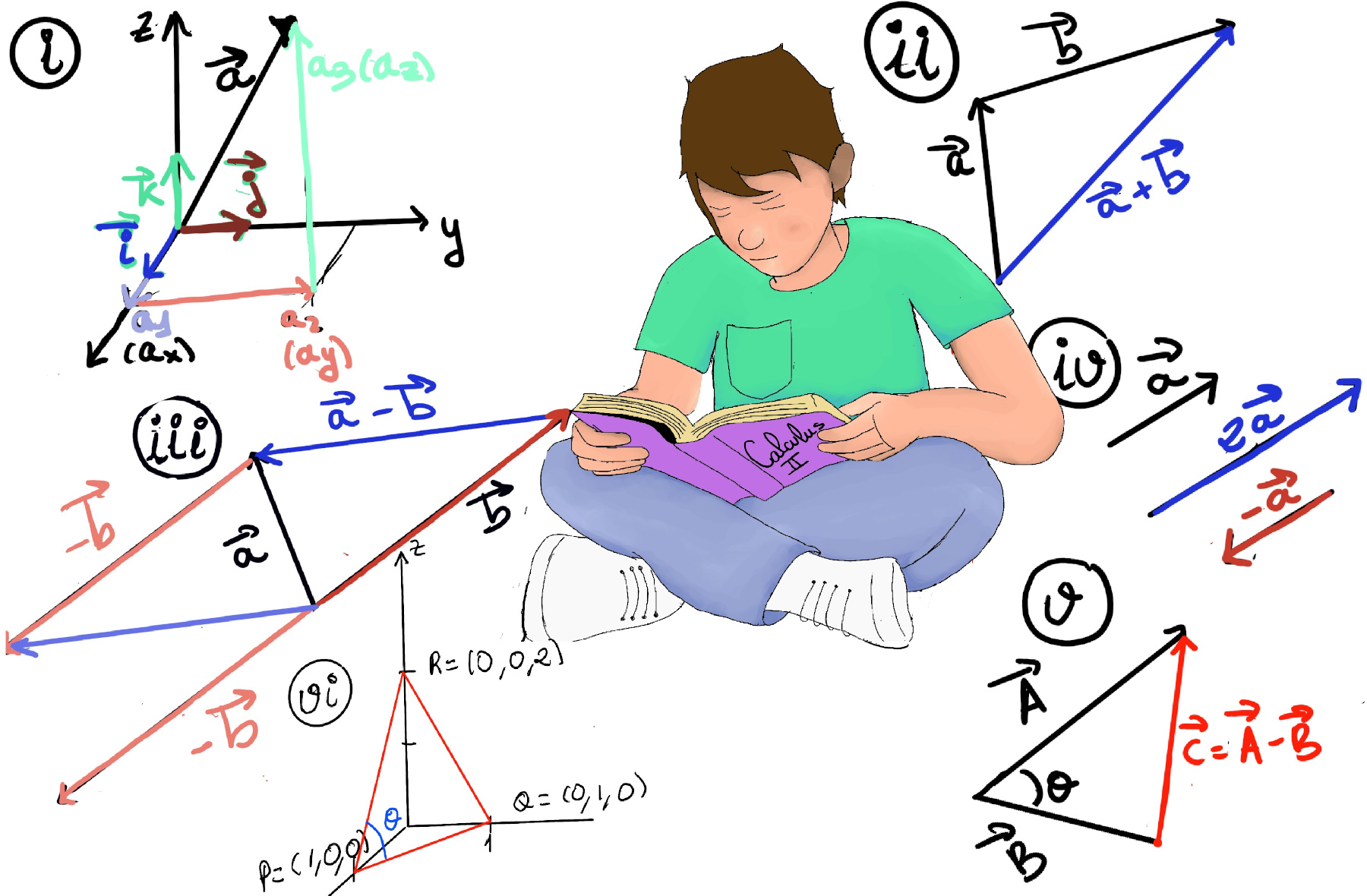
|
 |
 |

|
 |
 |
Irony is wasted on the stupid, Oscar Wilde.
I have yet to see any problem, however complicated, which, when looked at in the right way did not become still more complicated, Paul Anderson.
Definition. A vector $\vec{AB}$ is a geometric object or quantity that has both magnitude (or length) and direction. Vectors in an n-dimensional Euclidean space can be represented as coordinates vectors in a Cartesian coordinate system. In the context of mathematics, physics, and engineering, vectors are used to describe various physical quantities, such as force, velocity, acceleration, fluid flow, momentum, electric and magnetic fields, etc.
The point A from where the vector starts is called its initial point, and the point B where it ends is called its terminal point. The distance between initial and terminal points of a vector is called the magnitude of the vector, denoted as $|\vec{AB}|$ or $||\vec{AB}||$. The magnitude of a vector represents its size or length. The arrow indicates the direction of the vector, $\vec{AB}$ represents a vector that starts from point A and ends at point B.
Typically, the standard basis vectors are often denoted as $\vec{i},~\vec{j},~\vec{k}$, thus $\vec{A} = a_1\vec{i}+a_2\vec{j}+a_3\vec{k}$ = < a1, a2, a3 > (Figure i). Each component of the vector corresponds to the magnitude of the vector in the respective direction. $\vec{A} = a_1\vec{i}+a_2\vec{j}+a_3\vec{k}$ represents a vector with components a1, a2, and a3 along the x, y, and z axes respectively.
 Definition. The magnitude of the vector $\vec{A}$, also known as length or norm, is given by the square root of the sum of its components squared, $|\vec{A}|~ or~ ||\vec{A}|| = \sqrt{a_1^2+a_2^2+a_3^2}$, e.g., $||< 3, 2, 1 >|| = \sqrt{3^2+2^2+1^2}=\sqrt{14}$, $||< 3, -4, 5 >|| = \sqrt{3^2+(-4)^2+5^2} = \sqrt{9+ 16 + 25} = \sqrt{50}=5\sqrt{2}$, or $||< 1, 0, 0 >|| = \sqrt{1^2+0^2+0^2}=\sqrt{1}=1$.
Definition. The magnitude of the vector $\vec{A}$, also known as length or norm, is given by the square root of the sum of its components squared, $|\vec{A}|~ or~ ||\vec{A}|| = \sqrt{a_1^2+a_2^2+a_3^2}$, e.g., $||< 3, 2, 1 >|| = \sqrt{3^2+2^2+1^2}=\sqrt{14}$, $||< 3, -4, 5 >|| = \sqrt{3^2+(-4)^2+5^2} = \sqrt{9+ 16 + 25} = \sqrt{50}=5\sqrt{2}$, or $||< 1, 0, 0 >|| = \sqrt{1^2+0^2+0^2}=\sqrt{1}=1$.
Definition. Any vector with magnitude of 1, i.e., $|\vec{A}|~ or~ ||\vec{A}|| = \sqrt{a_1^2+a_2^2+a_3^2} = 1$, is called a unit vector.
The sum of two vectors is the sum of their components, $\vec{A}+ \vec{B} = (a_1+b_1)\vec{i}+(a_2+b_2)\vec{j}+(a_3+b_3)\vec{k}$ = < (a1+b1), (a2+b2), (a3+b3) >, e.g., $\vec{A}+\vec{B} = ⟨3, 2⟩ + ⟨5, 6⟩ = ⟨8, 8⟩, \vec{A}+\vec{B} = ⟨2,−1,3⟩ + ⟨−3,4,1⟩ = ⟨−1,3,4⟩, \vec{A}+\vec{B} = <3, 3, 3> + <1, 0, −1> = <4, 3, 2>$.
The subtraction of two vectors is similar to addition and is also done component-wise, it is given by simply subtracting their corresponding components (x, y, and z in 3D), $\vec{A} - \vec{B} = (a_1-b_1)\vec{i}+(a_2-b_2)\vec{j}+(a_3-b_3)\vec{k}$ = < (a1-b1), (a2-b2), (a3-b3) >, e.g., $\vec{A}-\vec{B} = ⟨2,−1,3⟩ - ⟨−3,4,1⟩ = ⟨5, -5, 2⟩, \vec{A}-\vec{B} = ⟨6, -2, -5⟩ - ⟨-4, 7, -8⟩ = ⟨10, -9, 3⟩, \vec{B}-\vec{A} = ⟨-4, 7, -8⟩ - ⟨6, -2, -5⟩ = ⟨-10, 9, -3⟩.$
It may be represented graphically by placing the tail of the second vector $\vec{b}$ at the head of the first vector $\vec{a}$, and then drawing an arrow from the tail of the first vector to the head of the second. The new arrow drawn represents the vector $\vec{a+b}$ (Figure ii) and this is called the parallelogram rule because $\vec{a}$ and $\vec{b}$ form the sides of a parallelogram and $\vec{a+b}$ is one of the diagonals.
To subtract $\vec{B}$ from $\vec{A}$, place the tails of $\vec{A}$ and $\vec{B}$ at the same point, and then draw an arrow from the head of $\vec{B}$ to the head of $\vec{A}$ (Figure iii).
Intuitively, multiplying a vector by a scalar r stretches it out by a factor of r. Geometrically, this can be visualized as placing r copies of the vector in a line where the endpoint of one vector is the initial point of the next vector. If r is negative, then the vector changes direction or flips around (by an angle of 180°).
The dot or scalar product is a fundamental operation between two vectors. It produces a scalar quantity that represents the projection of one vector onto another. The dot product is the sum of the products of their corresponding components: $\vec{A}·\vec{B} = \sum a_ib_i = a_1b_1 + a_2b_2 + a_3b_3.$
Examples: $\vec{A}·\vec{B} = \sum a_ib_i = ⟨2, 2, -1⟩·⟨5, -3, 2⟩ = a_1b_1 + a_2b_2 + a_3b_3 = 2·5+2·(-3)+(-1)·2 = 10-6-2 = 2; \vec{A}·\vec{B} = ⟨3, 5, 2⟩·⟨-1, 3, 0⟩ = 3·(-1)+5·3+2·0 = -3 + 15 + 0 = 12, \vec{A}·\vec{B} = ⟨-3, 2, 2⟩·⟨-4, 2, 1⟩ = (−3)⋅(−4)+ 2⋅2 +2⋅1 = 12 + 4 + 2 = 18.$
Properties: